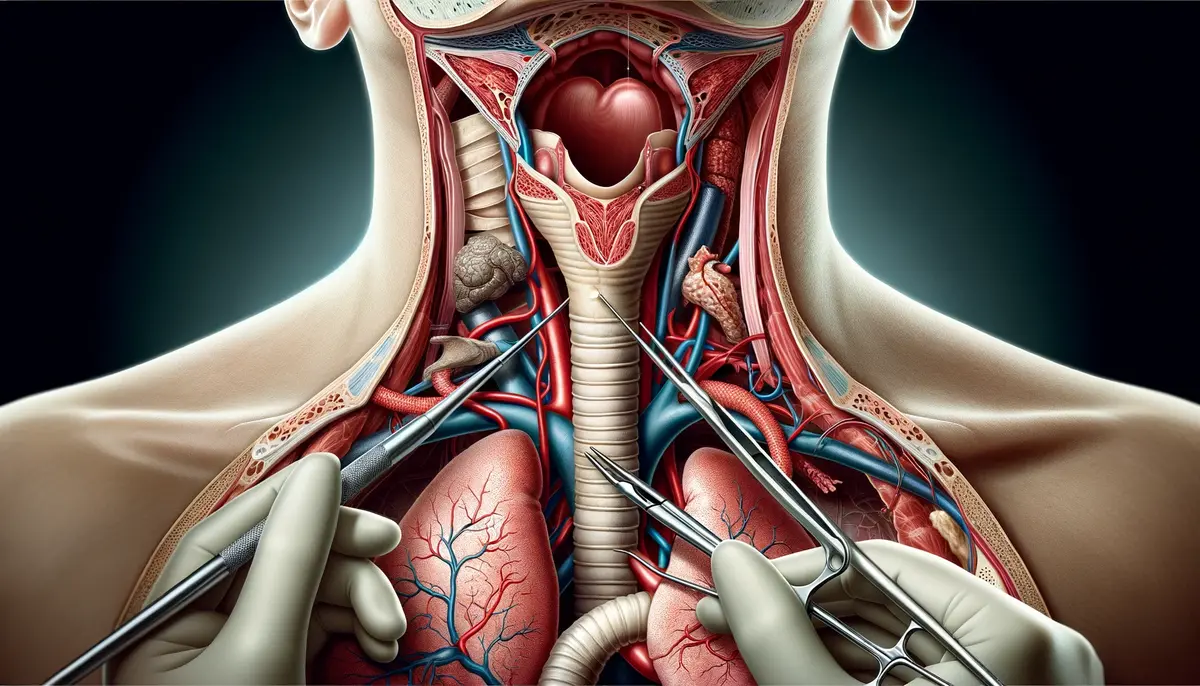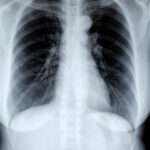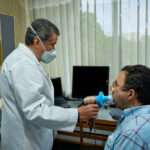Tracheal Surgery in Mumbai
Tracheal surgery refers to a range of surgical procedures performed on the trachea, also known as the windpipe. The trachea is the airway that connects the voice box (larynx) to the lungs. Tracheal surgery corrects various issues that can arise within the trachea, including blockages, strictures, tumors, or injuries. The type of tracheal surgery that is performed will depend on the specific nature of the problem that is being addressed.
Very few thoracic surgeons in Mumbai perform tracheal surgeries. Dr George Karimundackal and his team are one of the foremost experts in tracheal procedures in Mumbai.

Essential diagnostic assessments before tracheal surgery
Tests and procedures to assess the trachea and surrounding structures before proceeding with a tracheal surgery are:
- Chest X-ray: Provides a basic image of the lungs, trachea, and heart to identify abnormalities or changes in the chest.
- Computed Tomography (CT) Scan: Offers detailed cross-sectional images of the chest, including the trachea to detect narrowing, blockages, or other structural issues.
- Bronchoscopy: A procedure where a flexible tube with a camera (bronchoscope) is inserted through the mouth or nose into the trachea and lungs to view the airway directly
Pulmonary Function Tests (PFTs): Measure the working of the lungs despite the affected trachea.
- Laryngoscopy: Examines the back of the throat, voice box, and vocal cords.
- Biopsy: Involves taking a small tissue sample from the trachea or nearby areas for examination, particularly if a tumor is suspected.
- Positron Emission Tomography (PET) Scan: Often combined with a CT scan (PET/CT), this test can help in identifying spread of cancer.
These diagnostic tests and procedures help healthcare providers identify tracheal issues accurately, understand their severity, and plan appropriate treatment strategies, including tracheal surgery.
Consult Dr George Karimundackal, a leading airway surgeon in Mumbai, who will guide you through the relevant tests and also suggest treatment options for complex chest and tracheal disorders.
Take the Leap to Clear Breathing - Choose Dr. George for Tracheal Surgery
Types of Tracheal Surgery
Tracheal surgery refers to a range of surgical procedures performed on the trachea, also known as the windpipe, which is the airway that connects the voice box (larynx) to the lungs. This surgery is typically conducted to correct problems such as blockages, strictures (narrowing), tumors, or injuries within the trachea. The specific type of tracheal surgery depends on the nature of the tracheal problem.
Curious about the process? Let’s explore what effective treatment looks like…
Tracheal Resection and Reconstruction:
This surgery involves removing a segment of the trachea that is narrowed or damaged (often due to tracheal stenosis) and then reconstructing the trachea. The reconstruction can be done by suturing the remaining ends together.
Tracheostomy:
A tracheostomy creates a direct airway through an incision in the neck into the trachea. This procedure is often performed in emergency situations or for patients who need long-term ventilation support.
Tracheal Dilatation:
This procedure is used to widen a narrowed trachea. It can be performed using a balloon (balloon dilatation) or rigid instruments.
Stent Insertion:
Tracheal stents are used to keep the trachea open in cases of obstruction or narrowing. Stents can be either temporary or permanent, depending on the patient’s condition.
Laser Surgery:
Laser surgery is used to remove growths or obstructions in the trachea. This minimally invasive technique is often used for treating tracheal tumors.
Tracheopexy:
This surgical procedure is used to correct tracheomalacia (a condition where the tracheal walls are weak) by providing external support to the trachea.
Cricotracheal Resection:
This is a more complex procedure where part of the trachea and the cricoid cartilage are removed, typically for severe cases of subglottic stenosis.
Endoscopic Tracheal Surgery:
This minimally invasive surgery is performed using an endoscope. It is often used for removing small tumors or foreign bodies, or for minor repairs.
Carinal Resections:
This is a surgery which involves the lower end of the trachea where it divides into the two lungs. Removal of this portion with reconstruction is a very complex procedure and is performed by very few surgeons.
Tracheal surgeries are complicated and need expert surgeons. They work with a team of experts from other fields to plan, before, during, and after-surgery care.
Dr. George Karimundackal is among the most experienced thoracic surgeons in Mumbai, with a remarkable track record of successful surgeries. His comprehensive approach towards his patients and guidance amongst his fellow medical professionals are a testament to his unwavering commitment to thoracic surgery
Experience advanced surgical techniques for tracheal issues – Reach out for more info.
Risks involved in Tracheal Surgery
The risks involved in tracheal surgery can include:
- Airway maintenance: Maintaining a patent airway before during and after the procedure is difficult and the most critical component of the surgery.
- Bleeding: There’s always a risk of bleeding during and after tracheal surgery.
- Voice Changes: If the surgery affects the vocal cords or nerves; it can change your voice.
- Prolonged Ventilation: Need to use a breathing machine for a long time after surgery.
- Tracheostomy: Creation of a breathing hole in the neck, either for a brief period or permanently
- Scarring and Stenosis: The narrowing of the trachea (stenosis), which needs more treatment
- Infection: Surgical sites can become infected, which needs further treatment
Discussing these risks in detail with the thoracic surgeon performing the procedure is essential. The risks can vary based on the patient’s overall health, the specific type of tracheal surgery and the patient’s response to surgery.
Effective tracheal resection post-operative care minimises complications and ensures a smooth recovery process. Dr. George Karimundackal and his team have vast experience in managing complex airway procedures
Post-treatment follow-up
The recovery time following tracheal resection surgery varies based on individual health factors but typically involves a structured rehabilitation plan.
Interested in how we approach recovery? Here’s the key…
- Early mobilisation and removal of drains
- Early initiation of chest physiotherapy
- Coughing and breathing exercises
- Good dietary regimen
- Appropriate antibiotic therapy
After tracheal surgery, it’s vital to keep up with your health. This means:
- Regular Doctor Visits: You need to see your doctor or surgeon often so they can check your healing and detect problems early.
- Scans and X-rays: Tests like X-rays and CT scans help doctors see how your trachea is healing and check for any issues.
- Checking Your Voice and Breathing: If your surgery was near your vocal cords, your doctor might check your voice. The doctors will also see how well you’re breathing.
- Watching for Symptoms: Keep an eye out for new or worse symptoms like trouble breathing, a hoarse voice, coughing a lot, or pain, and tell your doctor if you have them.
- Taking Medicine Right: If you have medicines to take after surgery, like antibiotics or painkillers, it’s essential to take them correctly and watch for side effects.
- Physical Therapy: Physical therapy is essential after a major surgery.
- Learning Emergency Signs: You and your caregivers should know what signs mean you need urgent medical help.
- Emotional Support: Getting better can be tough physically and emotionally, so you might get support or counselling.
- Healthy Habits: Doctors might give you advice on quitting smoking, eating healthy, and exercising to help you get better faster.
Your follow-up plan will be made based on your surgery and needs.
Talking to your healthcare team helps a lot. They will make sure you recover well.
Dr George Karimundackal’s experience in tracheal surgery encompasses a wide range of procedures, from minimally invasive techniques to more extensive resections, catering to various tracheal conditions. His surgical competency and dedication in post-operative care and patient rehabilitation highlights his comprehensive expertise in this specialised medical field.
Frequently Asked Questions
Recovery from chest wall surgery depends upon the complexity of the surgery and individual patient factors. The patient should adhere to the postoperative instructions and visit the doctor for follow-ups at regular intervals to ensure a smooth recovery.On an average, the patient is discharged from the hospital within a week’s time and can return to routine activity by about a month.
The main expense in this surgery is related to the reconstructive material. However, a wide range of options exist for any defect and an informed and suitable choice can be made in each individual case, considering all factors.
Surgery for malignant tumors of the chest wall are elective procedures but should be expedited. Benign lesions can be scheduled as per convenience. Trauma surgery is generally emergent.
Some stage 4 esophageal cancer patients may live for more than a year. Around 20 out of 100 patients (or 20%) with stage 4 esophageal cancer will still be alive a year after diagnosis



 Pulmonary Function Tests (PFTs): Measure the working of the lungs despite the affected trachea.
Pulmonary Function Tests (PFTs): Measure the working of the lungs despite the affected trachea.